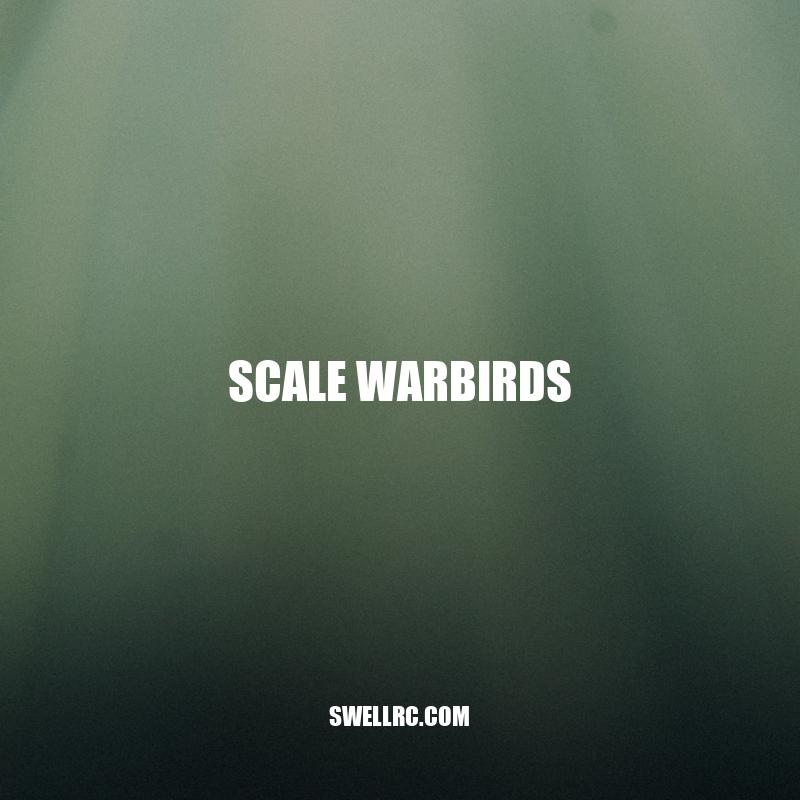Exploring the World of Scale Warbirds: Miniature Replicas of Classic Warplanes
Scale warbirds have become increasingly popular amongst aviation enthusiasts as they offer a unique and exciting way to relive and experience the history of aviation. These miniature replicas of classic warplanes are designed to resemble their original counterparts as closely as possible. From the P-51 Mustangs to the Spitfires and B-17 Flying Fortresses, scale warbirds come in various different types and scales. For many, these planes offer a way to connect with the past and learn about the history of aviation in a fascinating and informative way. The attention to detail and accuracy in the creation of these models is remarkable, with designers carefully studying the various aspects of the original planes to reproduce them in miniature form. From the materials used to build them, to the intricate design features and controls, every detail is crafted with precision and care. Not only do these models look authentic, but they can also be flown using remote controls, giving enthusiasts a chance to experience the thrill of flying vintage planes. The popularity of scale warbirds has led to the creation of different competitions and shows where enthusiasts can display their creations and compete against each other in categories such as flight performance and scale accuracy. The scale warbird community is growing, with more enthusiasts joining the ranks every day. For those interested in aviation and warplane history, scale warbirds offer a unique way to learn and experience the past.
Materials and Design
One of the fascinating aspects of scale warbirds is the level of detail and accuracy in their design. The materials used to create these models vary depending on the builder’s preferences and purpose, but most of them are made from popular materials such as balsa wood, plastic, or metal. Designers create these models by carefully studying the details of the original planes, resulting in a realistic and authentic-looking warbird. Here are a few notable points when it comes to design and materials:
- Builders use balsa and plywood as the primary raw materials for wooden scale models.
- Styrofoam and plastic materials are common in plastic scale models. They are lightweight, cheaper, and easier to use.
- Metal miniatures use aluminium or any metal alloy and are heavier than wooden or plastic models. They also have a better finish.
- Builders ensure that models’ wingspans, weight, and structures are proportional to that of the original plane.
- Decals and stickers, airbrushing, and weathering are applied to achieve authenticity in terms of paint job and markings.
It’s fascinating to see how designers can turn a pile of parts into an incredibly detailed and accurate replica of a vintage warbird. Numerous sites provide vast catalogs of scale warbirds kits for enthusiasts to choose from. Products like the P-51 Mustang Scale Model Kit and Spitfire 1/48 model are among the popular ones.
Types of Scale Warbirds
With so many different warplanes to choose from, it’s no surprise that builders and enthusiasts have created scale models of various types of airplanes. Each of them has unique features that make them interesting to model. Here are some of the most popular examples of scale warbirds:
| Scale Warbird | Description |
|---|---|
| Spitfires | A British fighter plane noted for its elliptical wings and agile maneuvers. Scale builders often choose this plane because of its sleek design and flying characteristics. |
| P-51 Mustangs | An iconic American fighter plane that played a key role in the allies’ victory during World War II. The Mustang’s design is famous for its speed, range, and power, and builders love replicating its long-range capability in their models. |
| B-17 Flying Fortresses | A famous American four-engine bomber that was used extensively in the Second World War. Scale builders love this plane because of its scale and complexity, building each of the miniaturized guns, turrets, and props that made it so lethal. |
| P-38 Lightning | An American fighter-plane with unique ‘boomerang’ shaped wings and twin tails. It was instrumental in escorting bombers in the Pacific theatre during World War II. Building a scale warbird with twin boom tails is a unique challenge that builders love to take up. |
Interesting fact: Experienced builders often design their models as a tribute to their parent or grandparent’s favorite plane or its pilot.
For those interested in purchasing scale model kits, there are various sites such as Scalehobbyist or Tower Hobbies that offer kits for different models. A few of the popular kits include the Spitfire Mk Vb Scale Model Kit, B-29 Superfortress Revell Model Kit, and P-38 Lightning Cutaway Plastic Model Kit.
What are the model aircraft categories?
Model aircraft are divided into two basic groups: flying and non-flying. Flying model aircraft categories include radio-controlled planes, gliders, helicopters, and multirotors. Non-flying model aircraft categories include scale models, static replicas, and display models. To learn more about model aircraft categories and get your own model planes, check out the websites of hobby shops and manufacturers such as HobbyKing and Horizon Hobby.
Building and Flying Scale Warbirds
Building a scale warbird requires time, patience, and attention to detail. Depending on the material and scale, a completed model can take anywhere from a few days to several months to build. The steps for building a scale warbird are as follows:
- Choose a warplane to model and source a blueprint or design
- Acquire the necessary materials such as balsa wood, plastic, and glue
- Cut and shape the various parts using specialized tools such as saws and sanders
- Assemble the parts according to the blueprint or design
- Precisely paint the warbird according to the original colors and markings
- Install the necessary components such as radio controls or motors for powered flight
- Test the warbird for balance and proper flight performance before taking it to the skies
Flying a scale warbird can be an exhilarating experience and requires a certain level of skill and knowledge. Different types of flight controls are used to fly these models, including hand controls and radio controls. An experienced builder may even opt to go for a virtual flight simulation to learn flying basics. Here are a few things to keep in mind when flying a scale warbird:
- Choose a suitable site that provides ample space for takeoff and landing
- Check that the warbird is balanced and the controls are working correctly
- Gradually increase throttle and altitude while maintaining control
- Practice basic maneuvers such as turns and loops before attempting advanced moves
Interesting Fact: Some scale warbird enthusiasts have taken their passion to the next level and created replicas of entire squadrons, complete with ground crew and vehicles.
For those starting, some online communities can offer help with design tips and advice on where to find good materials for building scale warbirds. Websites like RC Groups, Reddit RC, and Modelflying for example, offer forums that detail building processes and even review models.
Is it hard to build an RC plane?
Building an RC plane requires a little planning and basic materials but it is not necessarily hard. You can easily become an expert at building RC airplanes within a few hours. The essential components that you need include the fuselage, wings, rudder, wheels, motor, and radio transmitter. There are many websites and products available that can provide you with tips, guidance, and kits to help you build your own RC plane.
Scale Warbirds Competitions and Shows
Scale warbird competitions and shows are popular events among enthusiasts, allowing them to showcase their creations and compete against other builders. These events take place all over the world and attract thousands of spectators. During these competitions, judges evaluate the models based on their accuracy in design, quality of construction, and flight performance. There are several categories in which warbirds are judged, including:
- Scale accuracy: how accurately the model represents the original warplane
- Flight performance: how well the model performs during flight, including takeoff, maneuvers, and landings
- Static display: how well the model looks on display, including details such as weathering and markings
- Documentation: the documentation of the build process and research on the original warplane
Winning a scale warbird competition can bring a great deal of pride and recognition to a builder, cementing their status as a master modeler. Competitions and shows also provide an opportunity for enthusiasts to meet and share knowledge, tips, and ideas.
In addition to competitions and shows, there are also online communities and forums where scale warbird enthusiasts can connect. These communities provide a platform for builders to share their work, discuss techniques and tools, and offer advice to others.
Overall, scale warbirds are a unique and fascinating hobby that allows enthusiasts to combine their love of aviation, model building, and history. Whether it’s building, flying, competing, or simply admiring, there’s something for everyone who is passionate about these miniature replicas of classic warplanes.



